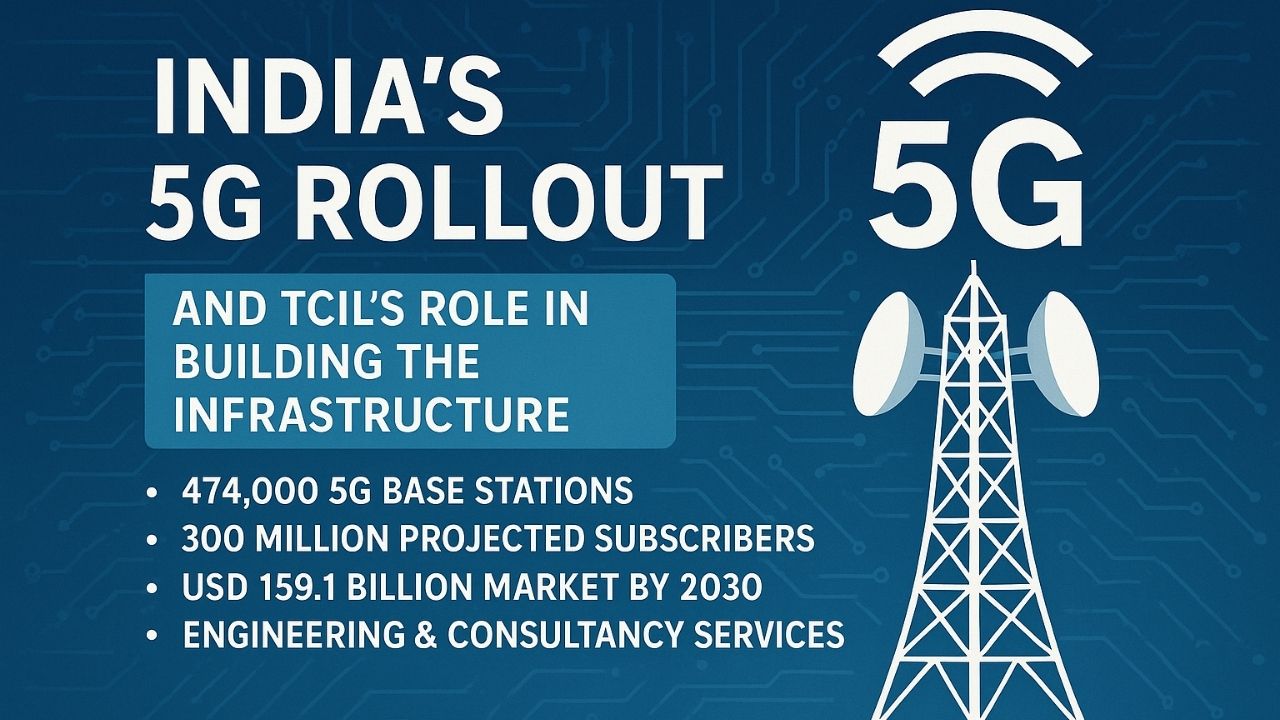India’s telecommunications landscape is undergoing a massive transformation with the rapid rollout of 5G services across the country. This advancement is not just a step forward in network speed, but a foundational shift that will support critical applications in manufacturing, agriculture, smart cities, healthcare, and logistics. The government has set an ambitious target of achieving 100% 5G coverage in all urban areas and key rural pockets by 2026. By March 2025, India had already crossed the milestone of installing over 474,000 5G base stations, signaling a strong commitment to building the backbone of a connected future.
The 5G subscriber base in India is projected to surpass 300 million users by the end of FY 2025. This sharp increase is attributed to a combination of low-cost data plans, competitive handset pricing, and telecom giants racing to establish nationwide coverage. While Reliance Jio and Bharti Airtel dominate the market, Vodafone Idea and BSNL are catching up with targeted deployments and indigenous solutions.
Telecommunications Consultants India Limited (TCIL), a key government undertaking, has emerged as a vital force in enabling the 5G infrastructure. With its legacy of delivering end-to-end telecom solutions both in India and abroad, TCIL is now engaged in consultancy, deployment, and innovation support for the 5G ecosystem.
India’s 5G Ecosystem: Network, Spectrum, and Subscriber Growth

The rollout of 5G in India began with spectrum auctions in mid-2022 and saw aggressive participation from leading private telecom companies. Jio, Airtel, and Vodafone Idea secured bandwidth in critical frequency ranges such as 700 MHz (low-band), 3300 MHz (mid-band), and 26 GHz (millimeter wave) to ensure widespread and high-speed coverage.
Jio has prioritized a Standalone (SA) 5G architecture, which is more advanced and future-proof, while Airtel has implemented a Non-Standalone (NSA) 5G system that leverages existing 4G core networks for faster deployment. This divergence has enabled rapid expansion across urban centers while laying the foundation for seamless upgrades in the future.
BSNL is preparing for a mid-2025 launch of its 5G services using homegrown technologies in partnership with C-DoT. This not only supports the government’s Make in India initiative but also contributes to national security by reducing dependency on foreign vendors.
The table below summarizes the current landscape of 5G deployment in India:
| Telecom Operator | 5G Coverage Status | Technology Used | Notable Regions Covered |
|---|---|---|---|
| Reliance Jio | Nationwide (Tier 1–Tier 3) | Standalone (SA) | All states, urban + semi-rural |
| Bharti Airtel | 300+ cities, expanding rapidly | Non-Standalone (NSA) | Metros, tier-2 towns |
| Vodafone Idea | Initial launch in NCR | Planned SA/NSA | NCR, Bengaluru, Pune |
| BSNL | Expected by mid-2025 | Indigenous core | Focus on government & rural areas |
Infrastructure Backbone: Fiberization and Network Challenges
While 5G towers and spectrum allocations are vital, the true enabler of high-speed data transmission lies in fiber connectivity. Currently, only 33% of telecom towers in India are fiberized—far short of the global best practice of 70–80%. The limited backhaul capacity poses a constraint on the full performance potential of 5G, particularly in high-density areas.
Furthermore, India faces logistical challenges in laying new fiber due to fragmented municipal clearances, high Right of Way (RoW) charges, and coordination issues between central and state agencies. To address this, the Department of Telecommunications has issued guidelines to standardize RoW policies and incentivize private-public collaboration.
Alongside fiberization, satellite connectivity and microwave links are being explored to support remote area coverage. With India’s geographic diversity and vast rural population, hybrid models may become essential in ensuring inclusive 5G access.
| Metric | India (2025) | Global Benchmark | Gap to Address |
|---|---|---|---|
| Fiberized Towers | ~33% | 70–80% | High |
| Average Spectrum Holding/Op | 300–400 MHz | 500–600 MHz | Moderate |
| Latency in Urban Networks | ~15 ms | <10 ms | Achievable with optimization |
| Avg. Data Consumption/User | 28–30 GB/mo | 35–40 GB/mo | Increasing steadily |
TCIL’s Role: Bridging Policy, Projects, and Practical Implementation
Telecommunications Consultants India Limited (TCIL), under the Department of Telecommunications, serves as a crucial node in India’s 5G infrastructure development. As a Mini Ratna PSU, TCIL has extensive experience in executing national and international telecom projects, including laying optical fiber, setting up telecom exchanges, and offering advisory services for large-scale rollouts.
In the context of 5G, TCIL’s involvement is multi-pronged:
- Consultancy Services: Assisting state governments, central departments, and PSUs in network planning and 5G readiness assessments.
- Project Implementation: Executing BharatNet Phase II fiber expansion, smart pole deployments in Smart Cities Mission, and public Wi-Fi integration projects.
- Collaboration with Global Partners: Engaging with international firms for AI-based telecom diagnostics, submarine cable systems, and 5G-specific R&D.
These interventions ensure that India’s 5G foundation is not only strong but also adaptable to future demands.
5G Use Case Labs: Capacity Building for Tomorrow’s Workforce
To support innovation and skill development, TCIL has launched the 5G Use Case Labs initiative in collaboration with academic institutions. The labs are designed to give students and faculty real-time exposure to 5G architecture, enabling them to develop applications for agriculture, smart energy, mobility, and digital healthcare.
Under this initiative, each lab is provided with:
- Testbed equipment and access to live 5G networks
- Software suites for AI, IoT, and 5G application prototyping
- Academic-industry mentoring programs for live projects
These labs are pivotal in producing industry-ready talent and indigenous solutions.
Benefits of TCIL’s 5G Use Case Labs
- Strengthens academia-industry collaboration
- Promotes indigenous technology development
- Reduces dependence on foreign R&D
- Accelerates innovation in rural and sectoral use cases
Regulatory and Investment Framework
The Government of India has enacted supportive policies to boost the telecom sector. The Telecommunications Act, 2023 simplified licensing norms, enabled spectrum sharing and leasing, and prioritized ease of doing business for infrastructure development. The Production-Linked Incentive (PLI) Scheme for telecom gear manufacturing has already attracted investments worth over ₹4,000 crore.
Further, the National Broadband Mission and Digital India program have emphasized last-mile connectivity, with 5G being a natural extension of this vision. According to industry estimates, the total investment needed for pan-India 5G rollout exceeds ₹2.5 lakh crore over the next 5 years.
Private players are also stepping up:
- Reliance Jio has committed ₹2 trillion towards 5G and digital services.
- Airtel has outlined ₹75,000 crore in network modernization plans.
- Several state governments are integrating 5G into their smart infrastructure roadmaps.
Key Government Programs Supporting 5G Expansion
- National Digital Communications Policy 2018
- Telecom Technology Development Fund
- 5G Spectrum Auction Reforms
- BharatNet and PM-WANI Schemes
- Telecom Sector PLI Incentive Scheme
Building a Future-Ready India
India’s 5G rollout is not just about speed—it is about scale, security, and self-reliance. The transformation will impact every aspect of life, from classrooms to hospitals, from factories to farmlands. The challenge lies not only in deploying infrastructure but in making it accessible, sustainable, and innovation-friendly.
TCIL’s foundational role in this journey, from policy execution to on-the-ground implementation and skilling, exemplifies the synergy needed between the government and technical agencies. With India poised to become one of the largest 5G user bases globally, sustained collaboration, investment, and innovation will determine how successfully it harnesses this technological revolution.

Aarav Sharma is a dedicated content specialist with a strong focus on Indian government schemes, recruitment updates, and social welfare policies. With a background in public administration, he simplifies complex regulations for everyday readers. Aarav’s articles are known for their clarity, accuracy, and data-driven insights.